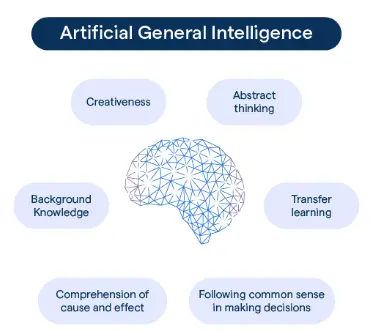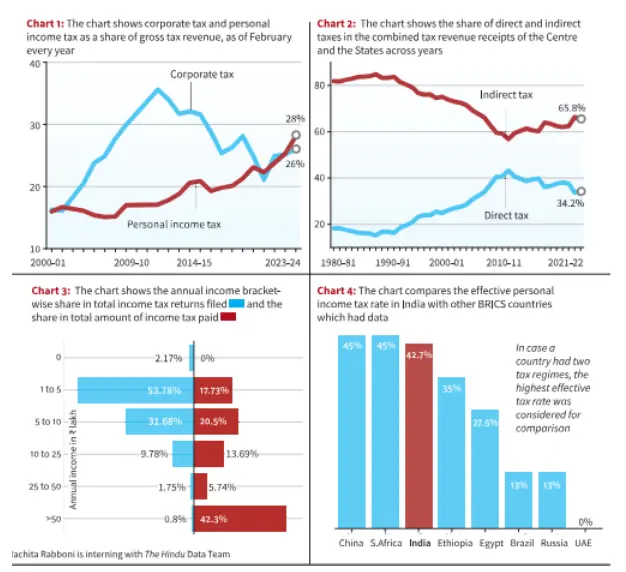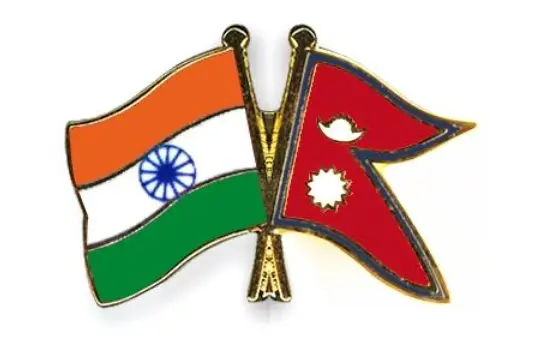Friday, 10th May 2024
India's Pharmaceutical Industry
In News: In the fiscal year 2022-23, India reached a notable milestone in the medical goods sector by becoming a net exporter of medical consumables and disposables for the first time.

Status of India's Pharmaceutical Industry
- Manufacturing and Export
- India, historically reliant on medical imports, has transitioned to self-sufficiency in medical consumables and disposables, becoming the largest global manufacturer of generic medicines.
- The industry is valued at USD 50 billion and serves over 200 countries, with projections to reach USD 65 billion by 2024 and USD 130 billion by 2030.
- Export and Import Statistics
- Exports of medical consumables and disposables surged by 16% to USD 1.6 billion, while imports declined by 33% to approximately USD 1.1 billion.
Challenges
- Lagging R&D: India's pharmaceutical R&D expenditure is lower compared to developed nations, hindering new drug development.
- Limited Innovation Ecosystem: Weak collaboration between academia, research institutions, and pharmaceutical companies slows down high-quality drug and medical device development.
- Price Controls and Profit Margins: Government price controls on some drugs can limit profits and deter heavy R&D investment.
- Complex Regulatory Framework: Lengthy and complex approval processes for new drugs lead to bureaucratic hurdles.
- Skilled Workforce Shortage: Shortage of highly qualified scientists and researchers affects efficiency.
- Intellectual Property Concerns: Uncertainty around IP protection discourages large pharma investment.
- Import Dependency: India heavily relies on imports for medical devices and APIs, particularly from China.
- Substandard Drugs: Occurrence of deaths linked to substandard or counterfeit drugs tarnishes the sector's reputation.
Reform Suggestions
- Legislative Changes and Centralised Database: Amend the Drugs and Cosmetics Act (1940) and establish a centralised drugs database for enhanced regulation.
- Encouraging Certification: Encourage more units to obtain WHO Good Manufacturing Practice certification to elevate industry-wide quality standards.
- Transparency, Credibility, and Accountability: Enhance India's drug regulatory regime for transparency and alignment with global standards.
- Focus on Sustainable Manufacturing Practices: Emphasise green chemistry, waste reduction, and energy efficiency for environmental sustainability.
- Moving Beyond Generics: Government support and initiatives like PLI can facilitate the development of novel drugs.
- Boosting R&D and Innovation: Foster public-private partnerships and provide tax incentives for innovation to improve R&D expenditure.
|
UPSC Previous Year Questions Prelims (2019) Q. Which of the following are the reasons for the occurrence of multi-drug resistance in microbial pathogens in India?
Select the correct answer using the code given below. (a) 1 and 2 Ans: (b) Mains (2019) Q. How is the Government of India protecting traditional knowledge of medicine from patenting by pharmaceutical companies? |
Source: ET
Challenge to the Maintainability of CBI Probes
In News: The Supreme Court has yet to deliver its verdict on West Bengal's suit alleging that the CBI is conducting investigations into post-poll violence cases without the state's consent. The Centre argued that West Bengal's suit under Article 131 is not maintainable and constitutes an abuse of legal process.
Article 131 of the Constitution of India
- Description: Article 131 empowers the Supreme Court to exclusively adjudicate disputes between different units of the Indian Federation.
- Disputes Covered:
- Disputes between the Government of India and one or more states.
- Disputes between the Government of India and any state(s) on one side and one or more states on the other.
- Disputes between two or more states if they involve a question of law or fact on which the existence or extent of a legal right depends.
Central Bureau of Investigation (CBI)
- Description: The CBI operates under the Ministry of Personnel, Public Grievances and Pensions and is India's premier investigating agency.
- Origin: Tracing its roots to the Delhi Special Police Establishment (DPSE) Act, 1946, the CBI was formed through an executive order of the government.
- Jurisdiction
- Originally established to investigate cases of corruption in government departments, the CBI now handles various economic crimes and special cases.
- Investigative powers are divided into Anti-Corruption Division, Economic Offences Division, and Special Crimes Division.
- Consent for Investigation
- The DPSE Act's Section 6 allows the central government to direct CBI investigations within a state's jurisdiction with the state government's consent.
- However, the Supreme Court and High Courts can order CBI investigations without state consent.
- Consent types include general consent and specific consent, affecting the agency's investigative powers within a state.
- States Withdrawn General Consent
- Ten states, including Punjab, Jharkhand, and Kerala, have withdrawn general consent to CBI investigations.
- Impact of Withdrawal
- Withdrawal of general consent does not halt ongoing CBI probes or cases initiated by court orders.
- CBI can challenge the withdrawal in court and continue investigations with specific consent or court orders.
Centre's Plea on CBI Probes' Maintainability
- Background
- Originating from a suit filed by West Bengal under Article 131, accusing the Union government of unauthorized CBI investigations within the state.
- West Bengal's Stand
- Alleges continued CBI interference despite withdrawing general consent in 2018.
- Centre's Stand
- Argues the suit's dismissal, denying involvement in CBI investigations within states.
- Contends that CBI isn't a 'state' under Article 131, limiting the scope of the original suit.
- SC Observations
- Questioning the Centre's stance, the SC highlights Section 5(1) of the DSPE Act, granting the central government authority over CBI investigations across states.
Source: TH
Constructed Wetlands
In News: In recent times, there has been a notable transition towards constructed wetlands as a holistic and nature-centric approach for industrial wastewater treatment, contrasting with traditional methods that have shown limitations in handling the diverse range of pollutants present.
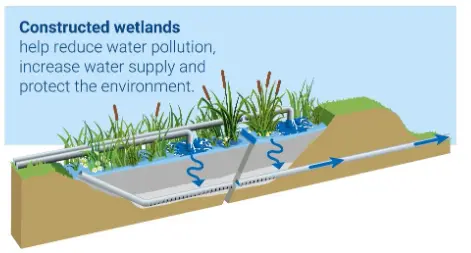
Constructed Wetlands: Overview
- Description: Constructed wetlands are human-made systems designed to mimic natural wetland processes for wastewater treatment, utilizing vegetation, soil, and water interactions.
- Types of Constructed Wetlands
- Subsurface Flow (SSF): Wastewater is passed through gravel beds or porous media underground, where microbial activity breaks down organic matter.
- Surface Flow (SF): Water flows above the surface, supporting diverse vegetation and creating visually appealing landscapes.
Benefits of Constructed Wetlands
- Environmental Benefits: They provide habitat for various plant and animal species, contribute to biodiversity, and offer ecosystem services like flood control and carbon sequestration.
- Cost-Effectiveness: Constructed wetlands are less expensive to build, operate, and maintain compared to traditional treatment methods.
- Nutrient Removal: They efficiently remove pollutants such as nitrogen, phosphorus, and organic matter from wastewater.
- Land Reclamation: These systems can reclaim land degraded by activities like mining by restoring natural wetland functions.
Applications of Constructed Wetlands
- Municipal Wastewater Treatment: Used as secondary or tertiary treatment stages to improve water quality before discharge or reuse.
- Stormwater Management: Effectively filters stormwater runoff, removing pollutants before entering natural waterways.
- Industrial Wastewater Treatment: Adapted to treat specific industrial wastewater types, depending on contaminants present.
- Agriculture: Treats agricultural runoff, reducing pollution and enhancing water quality for irrigation.
Challenges Associated with Constructed Wetlands
- Plant Selection: Critical for nutrient absorption and pollutant removal, requiring careful selection of species.
- Land Requirement: Construction needs significant land, posing limitations in urban areas.
- Treatment Efficiency: May not achieve the same purification level as conventional plants for heavily polluted water.
- Maintenance Needs: Regular upkeep essential to prevent clogging or mosquito breeding.
Way Forward
- Leveraging Global Best Practices: Learning from countries like Germany and the Netherlands in design optimization and performance monitoring.
- Implementing Constructed Wetlands in India: Establishing clear policy frameworks, exploring financing mechanisms, demonstrating success through pilot projects, and involving local communities in planning and operation.
|
UPSC Previous Year Questions Prelims (2014) Q. If a wetland of international importance is brought under the ‘Montreux Record’, what does it imply? (a) Changes in ecological character have occurred, are occurring or are likely to occur in the wetland as a result of human interference. Ans: (a) Mains (2018) Q. What is wetland? Explain the Ramsar concept of ‘wise use’ in the context of wetland conservation. Cite two examples of Ramsar sites from India. |
Source: DTE
WTO’s Agreement on Agriculture (AoA)
In News: The US and Australia have argued that India has exceeded the permissible limits for sugarcane subsidies outlined in the WTO’s Agreement on Agriculture (AoA), potentially distorting global trade.
Understanding WTO’s Agreement on Agriculture (AoA)
- Overview of AoA
- The Agreement on Agriculture (AoA) is an international treaty within the World Trade Organisation (WTO), established during the Uruguay Round of the General Agreement on Tariffs and Trade.
- It came into effect on January 1, 1995.
- Classification of Subsidies
- The AoA categorizes subsidies into three "boxes" based on their impact on production and trade: Amber, Blue, and Green.
- Amber subsidies, directly linked to production levels, are subject to reduction, while Green subsidies are exempt from reduction commitments but must adhere to certain criteria.
- Pillars of AoA
- Domestic Support: Divided into trade-distorting and non-trade-distorting categories, allowing significant spending by developed countries, leading to concerns about market distortion.
- Market Access: Involves tariff reductions for developed and developing countries, with exemptions for least developed countries (LDCs) and conditions for others to bind tariffs.
- Export Subsidies: Requires reduction targets for developed and developing countries over specified timeframes.
Criticism of AoA
- Civil society groups criticize AoA for reducing tariff protections for small farmers in developing countries while permitting continued subsidies by developed nations.
- NGOs argue that categorizing subsidies into trade-distorting and non-trade-distorting boxes allows developed countries to increase non-trade-distorting subsidies while pressuring others to reduce trade-distorting support.
Concerns about India’s Sugarcane Subsidies
- A US-Australia report alleges that India's sugar subsidies exceeded permissible levels, citing the WTO's methodology.
- India contests this, stating that its Fair and Remunerative Price (FRP) and State-Advised Prices (SAPs) do not constitute market price support under AoA.
- India's appeal against the WTO panel report of 2021 has prevented its adoption due to the non-functionality of the Appellate Body.
India’s Stand on Sugarcane Subsidies
- India sets the FRP for sugarcane each season, supplemented by premiums for efficiency and State-Advised Prices.
- India disputes the characterization of these measures as market price support under the AoA.
Impact of Non-Functional Appellate Body
The non-functionality of the WTO's Appellate Body has stalled decisions on appeals, including India's appeal against the WTO panel report.
Source: BL
The Glide Phase Interceptor (GPI) Project
In News: In response to escalating worries regarding adversaries deploying sophisticated armaments such as hypersonic missiles, Japan is dedicating resources to the Glide Phase Interceptor (GPI) Project, a collaborative endeavor with the United States.

The Glide Phase Interceptor (GPI) Project: Enhancing Regional Hypersonic Missile Defense
- Introduction
- The Glide Phase Interceptor (GPI) Project is a collaborative effort between the United States and Japan to develop a missile-intercepting system.
- Understanding the Glide Phase
- Traditional Intercontinental Ballistic Missiles (ICBMs) follow a parabolic trajectory driven by gravity after separation from their booster.
- In contrast, hypersonic weapons separate from their booster and accelerate towards the Earth using gravity. They then transition into a flatter trajectory known as the glide phase.
- During the glide phase, hypersonic vehicles travel at speeds exceeding five times the speed of sound on unpredictable trajectories.
- Challenges Posed by Hypersonic Weapons
- Hypersonic weapons fly at relatively low altitudes (20 to 80 km) during the glide phase.
- They have the capability to navigate around areas containing known missile defense sensors, making tracking difficult.
- Ground-based radar systems face challenges in efficiently tracking hypersonic missiles due to their speed and trajectory unpredictability.
- Objectives of the GPI Project
- The GPI Project aims to provide regional defense against hypersonic missiles.
- Specially modified missiles will be launched from surface warships to engage and destroy incoming hypersonic missiles.
- The intercept will occur as the hypersonic missiles glide through the boundary between space and Earth's atmosphere.
- The intercept during the glide phase provides the optimal opportunity to neutralize the threat before the missile enters its final high-speed descent.
Source: NN
Widal Test
In News: The Widal Test's susceptibility to producing inaccurate results is obscuring the true extent of India's typhoid burden, leading to heightened healthcare costs and amplifying the risk of antimicrobial resistance.

Understanding the Widal Test for Diagnosing Typhoid Fever
- Introduction to the Widal Test
- The Widal test is utilized for diagnosing typhoid fever, also known as enteric fever, caused by the bacterium Salmonella Typhi.
- This bacterial infection is commonly transmitted through contaminated food or water.
- Symptoms and Challenges of Typhoid Fever Diagnosis
- Symptoms of typhoid fever include fatigue, high fever, headache, diarrhea or constipation, abdominal pain, weight loss, and red spots.
- These symptoms overlap with those of other diseases such as malaria, dengue, influenza, and typhus, complicating diagnosis without proper testing.
- Principle and Application of the Widal Test
- The Widal test is a serological test that detects antibodies against Salmonella Typhi in a patient's blood sample.
- It aids in diagnosing current or recent infections and determining past exposure to typhoid bacteria.
- As a point-of-care test, it doesn't require specialized skills or infrastructure.
- Historical Background and Current Usage
- Developed in the late 1800s by a French physician, the Widal test is still employed in some regions for diagnosing typhoid fever.
- However, its usage has declined in many countries due to its limitations and flaws.
- Limitations of the Widal Test
- A single positive Widal test result doesn't confirm the presence of typhoid infection, and a negative result doesn't rule it out.
- Diagnosis of an active infection requires testing at least two serum samples taken 7-14 days apart, which is often impractical.
- In areas with high typhoid prevalence, baseline antibody levels may confound test interpretation.
- Cross-reactivity of test reagents with antibodies from other infections or vaccination can lead to false positives.
- Prior antibiotic therapy may impact antibody levels, resulting in false negatives.
Source: TH
AlphaFold3
In News: Google DeepMind has introduced the third significant iteration of its "AlphaFold" artificial intelligence model, with the aim of assisting scientists in the more efficient design of drugs and targeting diseases.
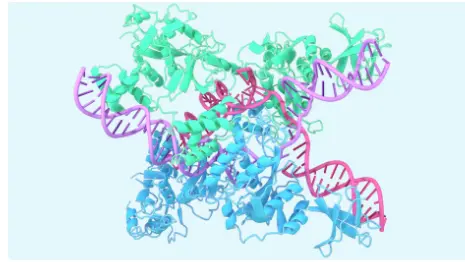
Exploring AlphaFold3: Revolutionizing Molecular Structure Prediction
- Introduction to AlphaFold3
- AlphaFold3 is a groundbreaking AI model jointly developed by Google DeepMind and Isomorphic Labs.
- It represents a significant advancement in predicting the structure and interactions of various molecules, including those crucial to life.
- Capabilities of AlphaFold3
- AlphaFold3 can predict the structure and interactions of all molecules with unprecedented accuracy, including human DNA.
- It generates joint 3D structures of molecules, providing insights into their arrangement and interactions.
- The model extends its predictions to encompass large biomolecules such as proteins, DNA, and RNA, as well as small molecules like ligands, which include many drugs.
- Additionally, AlphaFold3 can model chemical modifications that regulate cellular functions and may contribute to disease when disrupted.
- Methodology
- AlphaFold3 assembles its predictions using a diffusion network, a technique reminiscent of those employed in AI image generators.
- Significance of AlphaFold3
- AlphaFold3 offers scientists a comprehensive view of cellular systems, encompassing structures, interactions, and modifications.
- This newfound understanding of molecular connections enhances our comprehension of biological functions, including drug actions, hormone production, and DNA repair mechanisms.
Source: TH
Antarctic Treaty Consultative Meeting
In News: India will officially communicate to the Antarctic Treaty Consultative Meeting (ATCM) its intentions to construct a new research station in Antarctica.
Understanding the Antarctic Treaty Consultative Meeting and India's Engagement
- The Role of the Antarctic Treaty Consultative Meeting (ATCM)
- The Antarctic Treaty Consultative Meeting plays a pivotal role in global efforts to safeguard Antarctica's delicate ecosystem and advance scientific research in the region.
- Held annually under the Antarctic Treaty System, these meetings provide a platform for Antarctic Treaty Consultative Parties and other stakeholders to address environmental, scientific, and governance challenges in Antarctica.
- The Committee for Environmental Protection (CEP)
- Established in 1991 under the Protocol on Environmental Protection to the Antarctic Treaty (the Madrid Protocol), the Committee for Environmental Protection (CEP) advises the ATCM on matters related to environmental protection and conservation in Antarctica.
- Key Facts about the Antarctic Treaty
- Signed in 1959 and enforced in 1961, the Antarctic Treaty designates Antarctica as a region devoted to peaceful purposes, scientific collaboration, and environmental preservation. Currently, 56 countries are party to the Treaty.
- The Treaty enshrines principles such as the peaceful use of Antarctica, freedom of scientific inquiry, and the exchange of scientific findings from the region.
- India's Engagement with the Antarctic Treaty
- India became a Consultative Party to the Antarctic Treaty in 1983, participating in decision-making alongside 28 other Consultative Parties.
- India's involvement in Antarctic research dates back to the establishment of its first research station, Dakshin Gangotri, in 1983.
- Presently, India operates two year-round research stations: Maitri (established in 1989) and Bharati (established in 2012).
- Indian Scientific Expeditions to Antarctica have been conducted annually since 1981, facilitated by the country's permanent research stations.
- In 2022, India reaffirmed its commitment to the Antarctic Treaty by enacting the Antarctic Act.
- The Role of the Antarctic Treaty Secretariat (ATS)
- Established in 2004, the Antarctic Treaty Secretariat (ATS) serves as the administrative center for the Antarctic Treaty System.
- The ATS coordinates ATCM and CEP meetings, manages information repositories, and facilitates diplomatic exchanges and negotiations related to Antarctic governance and management.
Source: IE
Neural Processing Unit (NPU)
In News: Apple has introduced the M4 chip alongside the iPad Pro, featuring a significant upgrade in the form of a 16-core Neural Engine, which corresponds to Apple's version of a Neural Processing Unit (NPU).

Understanding the Neural Processing Unit (NPU)
- Introduction to NPU
- A Neural Processing Unit (NPU) is a specialized processor crafted explicitly to accelerate neural network computations, integral for various AI-related tasks.
- Functionality of Neural Networks
- Neural networks, akin to the human brain, are machine learning algorithms utilized for data processing across diverse applications.
- Applications of NPU
- NPUs excel in handling machine learning operations crucial for AI tasks, including speech recognition, natural language processing, object detection in images or videos, and more.
- Typically integrated into consumer electronics like smartphones, laptops, and tablets, NPUs are incorporated within the main processor, often adopting a System-on-Chip (SoC) configuration.
- Distinguishing NPU from CPU
- While CPUs operate through sequential computing, executing one instruction at a time, NPUs leverage parallel computing to simultaneously process multiple calculations. This parallel computing paradigm facilitates faster and more efficient processing.
- Furthermore, NPUs possess the ability to learn from accumulated data, enabling them to derive optimal solutions over time.
Source: BS
Dice Snake
In News: A recent study has revealed that dice snakes have the remarkable ability to simulate their own death when confronted by predators, employing a dramatic display that involves the expulsion of "mouthfuls" of blood.

Exploring the Dice Snake: A Nonvenomous Colubrid
- Introduction to the Dice Snake
- The Dice Snake, also known as a water snake, is a nonvenomous species belonging to the family Colubridae and the subfamily Natricinae.
- It exhibits distinctive characteristics and behaviors that make it unique within its habitat.
- Physical Characteristics
- Females of the Dice Snake species typically exhibit larger body sizes compared to males.
- Distribution and Habitat
- Dice Snakes are primarily distributed across much of Eurasia, with populations also present in Egypt.
- Their preferred habitats include areas near rivers, lakes, streams, ponds, and adjacent grasslands. Additionally, they can be found in coastal regions, plantations, and urban areas.
- Unique Behavioral Traits
- One notable behavior of the Dice Snake is its ability to feign death when threatened by predators. This tactic serves as a distraction, enabling the snake to evade predation.
- The effectiveness of this behavior depends on various factors such as the individual's sex, injuries, body temperature, size, age, presence of food in the stomach, presence of eggs in females, and previous encounters with predators.
- When feeling threatened, Dice Snakes can emit a foul-smelling secretion from their cloaca or simulate death to deter predators.
- Threats to the Dice Snake
- Despite being a nonvenomous species, Dice Snakes face several threats to their survival, including habitat loss due to wetland destruction, pollution, roadkill incidents, persecution by humans, and collection for the pet trade.
- Conservation Status
- According to the IUCN Red List, the Dice Snake is classified as Least Concern, indicating that it does not currently face significant threats to its overall population.
- However, conservation efforts are still essential to mitigate potential risks in the future.
Source: WION
Can India become a green superpower?
In News: India should strive to emerge as a green superpower by leveraging its potential to offer low-cost green hydrogen amid the global shift towards cleaner energy.
Why India Should Aim to be a Green Superpower
- Amitabh Kant's Perspective
- During the 'Raisina Dialogue 2024', Amitabh Kant, former NITI Aayog chief and G20 Sherpa, stressed India's need to become a net exporter of green energy by 2047 to attract capital.
- He emphasized that future investments would gravitate towards renewable energy sectors, making green approaches essential for capital attraction.
- Addressing the Global Challenge
- The pressing global challenge of climate change necessitates a shift towards renewable energy sources.
- Kant proposed transitioning the World Bank into a climate bank and advocated for each country, particularly those in the global south, to prioritize renewable energy.
- Biofuels as a Solution
- Kant highlighted the significant role of biofuels in creating jobs and achieving clean fuel targets, suggesting their importance in India's renewable energy strategy.
- Economic and Environmental Imperatives
- As the world moves towards cleaner energy, India has the potential to become a major producer of green hydrogen, contributing to both economic growth and environmental sustainability.
- India's Renewable Energy Growth
- India is currently implementing the world's largest renewable energy expansion program, aiming to install 500 GW of renewable capacity by 2030.
- This includes substantial investments in solar and wind energy and plans for green hydrogen production.
Steps for Achieving the Goal
- Financing the Green Transition
- Mobilizing financing is crucial for scaling up renewable energy investments, involving both local and international finance sources.
- Policy Tools for Driving Investment
- Enforcing Renewable Purchase Obligations (RPO) and Energy Storage Obligations (ESO) can boost demand for renewable energy and accelerate technological advancements in energy storage.
- Strengthening Infrastructure and Fiscal Reforms
- Enhanced public-private partnerships (PPPs) and fiscal incentives for clean energy can promote investment in low-carbon transport infrastructure and renewable energy projects.
- Institutional and Regulatory Strengthening
- Strengthening institutions like the Bureau of Energy Efficiency (BEE) and regulatory bodies will be crucial for scaling up clean energy projects and attracting investments.
- Leveraging Global Financial Mechanisms
- Increasing the role of global multilateral institutions and exploring mechanisms like multi-sovereign loan guarantees can improve access to finance for renewable energy projects.
- Policy and Regulatory Support
- Implementing policies and regulations that promote renewable energy technologies, including energy conservation codes and tariff policies, can further incentivize investment in green energy.
Conclusion
India's transition to a green superpower is not only about transforming its energy landscape but also about leading globally in sustainable development. Green infrastructure investments have significant economic benefits and contribute to building resilience against climate change.
Source: DH
Share the article
Edukemy’s Current Affairs Quiz is published with multiple choice questions for UPSC exams
MCQ
Get Latest Updates on Offers, Event dates, and free Mentorship sessions.

Get in touch with our Expert Academic Counsellors 👋
FAQs
UPSC Daily Current Affairs focuses on learning current events on a daily basis. An aspirant needs to study regular and updated information about current events, news, and relevant topics that are important for UPSC aspirants. It covers national and international affairs, government policies, socio-economic issues, science and technology advancements, and more.
UPSC Daily Current Affairs provides aspirants with a concise and comprehensive overview of the latest happenings and developments across various fields. It helps aspirants stay updated with current affairs and provides them with valuable insights and analysis, which are essential for answering questions in the UPSC examinations. It enhances their knowledge, analytical skills, and ability to connect current affairs with the UPSC syllabus.
UPSC Daily Current Affairs covers a wide range of topics, including politics, economics, science and technology, environment, social issues, governance, international relations, and more. It offers news summaries, in-depth analyses, editorials, opinion pieces, and relevant study materials. It also provides practice questions and quizzes to help aspirants test their understanding of current affairs.
Edukemy's UPSC Daily Current Affairs can be accessed through:
- UPSC Daily Current Affairs can be accessed through Current Affairs tab at the top of the Main Page of Edukemy.
- Edukemy Mobile app: The Daily Current Affairs can also be access through Edukemy Mobile App.
- Social media: Follow Edukemy’s official social media accounts or pages that provide UPSC Daily Current Affairs updates, including Facebook, Twitter, or Telegram channels.

